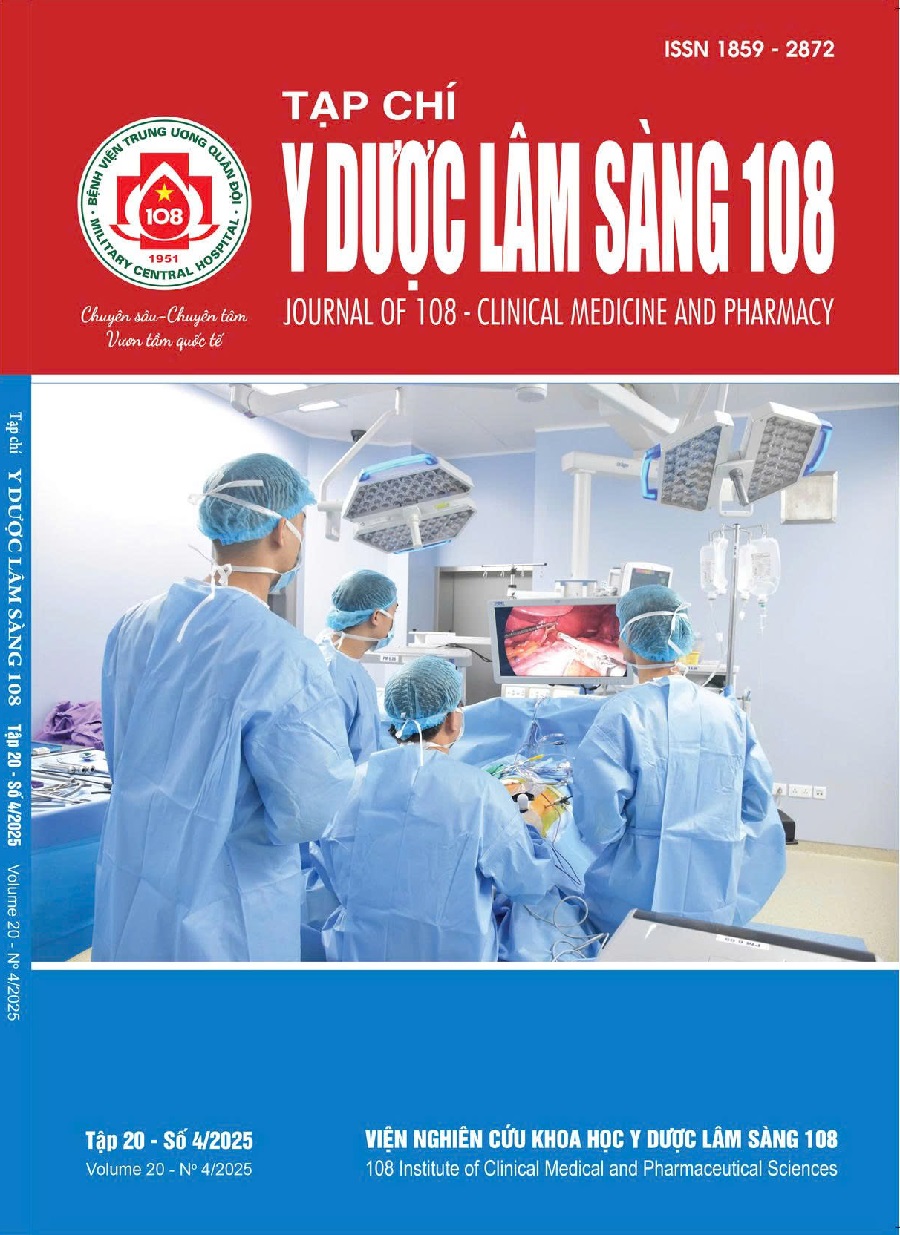Giá trị L-FABP niệu trong tiên lượng tử vong ở bệnh nhân nhiễm khuẩn huyết và sốc nhiễm khuẩn
Main Article Content
Keywords
Tóm tắt
Mục tiêu: Đánh giá giá trị của L-FABP niệu trong dự đoán tử vong ở bệnh nhân nhiễm khuẩn huyết và sốc nhiễm khuẩn. Đối tượng và phương pháp: Nghiên cứu mô tả tiến cứu trên 212 bệnh nhân nhiễm khuẩn huyết và sốc nhiễm khuẩn tại Bệnh viện Trung ương Quân đội 108 từ tháng 01/2021 đến tháng 8/2024. Mẫu nước tiểu được lấy lúc nhập viện và xét nghiệm L-FABP niệu, phân tích đa biến để xác định xem L- FABP có phải là biến độc lập trong dự báo tử vong trong vòng 7 ngày và tử vong nội viện. Kết quả: Nồng độ L-FABP niệu ở nhóm tử vong trong 7 ngày đầu là 31,71 (11,39-176,87) µg/g-Cre cao hơn nhóm sống sót [18,14 (5,09-35,45) µg/g-Cre], ở nhóm tử vong trong nội viện là 42,86 (17,71-73,63) µg/g-Cre cao hơn nhóm sống sót [12,11 (3,70-21,00) µg/g-Cre]. Tại điểm cắt L-FABP niệu = 19,34 µg/g-Cre có giá trị dự đoán tử vong nội viện với độ nhậy 70,2%, độ đặc hiệu 71,1%; AUC = 0,80. Kết luận: Nồng độ L-FABP niệu là có giá trị trong tiên lượng tử vong trong vòng 7 ngày và tử vong nội viện ở bệnh nhân nhiễm khuẩn huyết và sốc nhiễm khuẩn.
Article Details
Các tài liệu tham khảo
2. Kalakeche R, Hato T, Rhodes G et al (2011) Endotoxin uptake by S1 proximal tubular segment causes oxidative stress in the downstream S2 segment. J Am Soc Nephrol 22(8):1505-16. doi:10.1681/asn.2011020203
3. Asakage A, Ishihara S, Boutin L et al (2024) Predictive Performance of Neutrophil Gelatinase Associated Lipocalin, Liver Type Fatty Acid Binding Protein, and Cystatin C for Acute Kidney Injury and Mortality in Severely Ill Patients. Ann Lab Med 44(2): 144-154. doi:10.3343/alm.2023.0083
4. Doi K, Noiri E, Sugaya T (2010) Urinary L-type fatty acid-binding protein as a new renal biomarker in critical care. Current opinion in critical care 16(6): 545-549. doi:10.1097/MCC.0b013e32833e2fa4
5. Doi K, Noiri E, Maeda-Mamiya R et al (2010) Urinary L-type fatty acid-binding protein as a new biomarker of sepsis complicated with acute kidney injury. Crit Care Med 38(10): 2037-2042. doi:10.1097/CCM.0b013e3181eedac0
6. Singer M, Deutschman CS, Seymour CW et al (2016) The Third International Consensus Definitions for Sepsis and Septic Shock (Sepsis-3). Jama 315(8):801-10. doi:10.1001/jama.2016.0287
7. Rhodes A, Evans E, Alhazzan W et al (2017) Surviving sepsis campaign: International guidelines for management of sepsis and septic shock: Crit Care Med 45: 486-552.
8. Suzuki G, Ichibayashi R, Yamamoto S, Nakamichi Y, Watanabe M, Honda M (2019) Clinical significance of urinary L-FABP in the emergency department. International journal of emergency medicine 12(1): 24. doi:10.1186/s12245-019-0244-9
9. Parr SK, Clark AJ, Bian A et al (2015) Urinary L-FABP predicts poor outcomes in critically ill patients with early acute kidney injury. Kidney Int. Mar 2015;87(3):640-8. doi:10.1038/ki.2014.301
10. Xie Y, Li B, Lin Y, et al. Combining Blood-Based Biomarkers to Predict Mortality of Sepsis at Arrival at the Emergency Department. Med Sci Monit. Feb 25 2021;27:e929527. doi:10.12659/msm.929527
11. Seo MH, Choa M, You JS et al (2016) Hypoalbuminemia, Low Base Excess Values, and Tachypnea Predict 28-Day Mortality in Severe Sepsis and Septic Shock Patients in the Emergency Department. Yonsei Med J 57(6): 1361-1369. doi:10.3349/ymj.2016.57.6.1361
12. Thuijls G, van Wijck K, Grootjans J et al (2011) Early diagnosis of intestinal ischemia using urinary and plasma fatty acid binding proteins. Ann Surg. Feb 253(2): 303-308. doi:10.1097/ SLA.0b013e318207a767
13. Voth M, Holzberger S, Auner B, Henrich D, Marzi I, Relja B (2015) I-FABP and L-FABP are early markers for abdominal injury with limited prognostic value for secondary organ failures in the post-traumatic course. Clin Chem Lab Med 53(5): 771-780. doi:10.1515/cclm-2014-0354
 ISSN: 1859 - 2872
ISSN: 1859 - 2872
